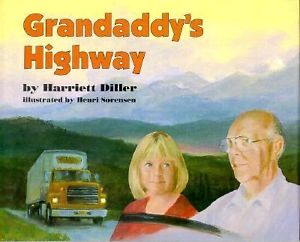
“As he tucked me in to bed, I glanced past him, out the window, to the strip of black across the yard. And I could see it — stretching all the way to the Pacific Ocean…”
That’s the last line of Grandaddy’s Highway, but it could just as easily be the first. As a little girl’s grandfather tucks her in bed at night, they watch the headlights of a passing truck cast light across her bedroom wall. But then the narrating little girl says, “We are headed as far west as you can go on 30 West.” When you turn the page, she and her grandfather are together in the truck’s cab — and he’s even honking its horn.
“On your right — the City of Pittsburgh, Pennsylvania. Squirrel Hill Tunnel directly ahead,” her grandfather narrates. But they’re just passing through, and the text only describes things you can see from the highway. Throughout the book, the author also sprinkles a couple of hints that this trip might be imaginary. “I can already see the squirrels,” the little girl says, “millions of them, watching me from the top of Squirrel Hill.”
The girl’s vivid imagination also serves another function, since it helps readers remember the (real) cities along the route of the famous highway. U.S. Route 30 includes much of the famous Lincoln Highway, the first single road that crossed all of America, according to Wikipedia. But even if you’re not trying to memorize its route, the book is educational in another way. Their trip travels from the east coast to the west coast of America — and it takes in many of the geographical landmarks you’d see along the way.
Author Harriett Diller mixes the details of the trip with the story of the girl’s responses. They’re sometimes very thoughtful, though the “naturalistic” story style may be challenging for young readers. Each page gets a wonderful watercolor illustration by Henri Sorensen (who also worked with Caldecott medal-winner Alvin Tresselt). Sorensen lives in Denmark, but according to the book’s jacket, “to get the feel of heading west in a tractor-trailer, he and a truck driver actually drove part-way west on U.S. Route 30.”
The publisher of the book thanks “the many people at Yellow Freight System, Inc, Overland Park, Kansas, who helped make ‘Grandaddy’s Highway possible.” (And Sorensen himself dedicates the book “to Donald Stover and Jan Cheripko, who made my trip on 30 West most enjoyable.”) But the book’s jacket also reveals that there’s another real-life adventure that may have played a role in Harriett Diller’s story. It reveals the plot is “loosely based on memories of her own summer nights watching the play of passing trucks’ headlights on the walls of her grandparents’ home near a Georgia highway.”
In the story, the girl and her grandfather pass through Chicago, and then approach the Mississippi River. (“Mist and river coolness rise from the brown water.”) There’s a beautiful drawing of the wide river at sunrise. And since Grandaddy needs a nap, he lets the little girl drive the truck.
Even if it is an imaginary trip, it looks like a wonderful bonding experience. They share a cup of coffee in a Nebraska diner that’s “lit up like a lightning bug in the hot night.” Grandpa lights a cigar as they ride past a Wyoming lake, and they point their truck towards the Rocky Mountains. And as the altitude gets higher, the little girl confesses that all the beautiful sights have been giving her goosebumps. There’s “The glow of town from the other side of a hill. The rattle of a train rushing off to who-knows-where.
“Wondering if the Wyoming sky is the same sky that hangs above Pennsylvania…”
